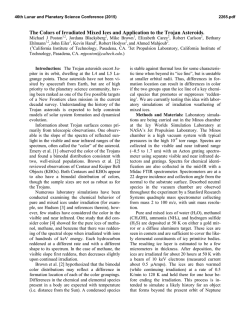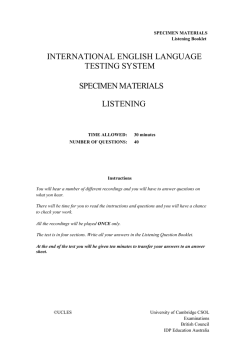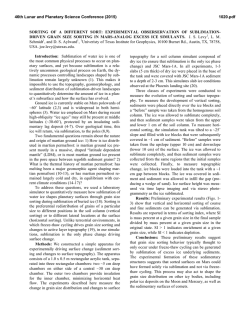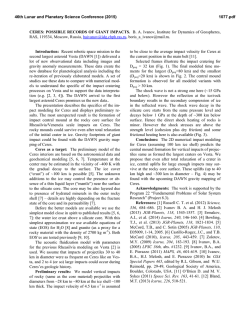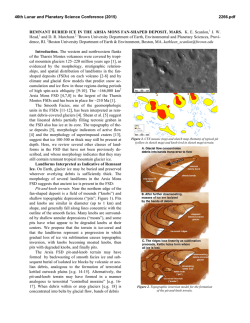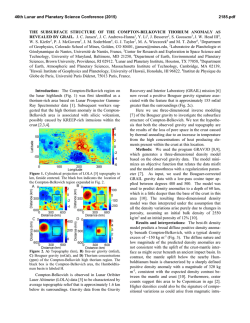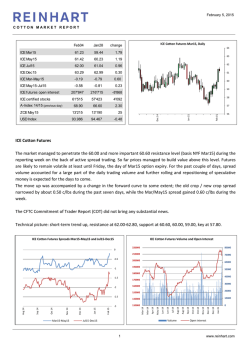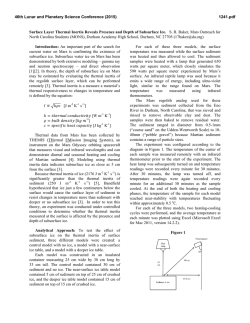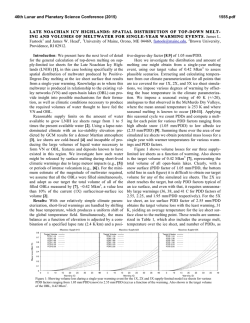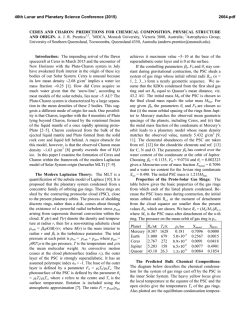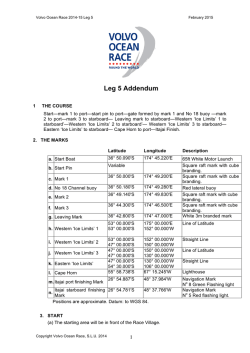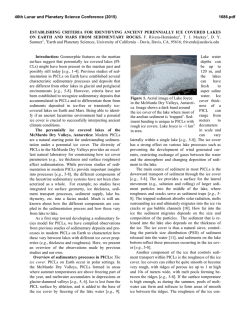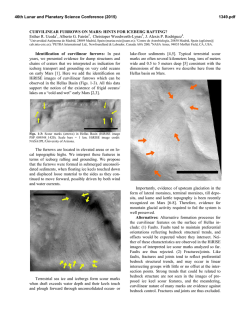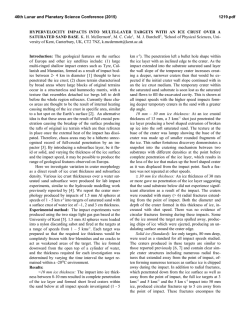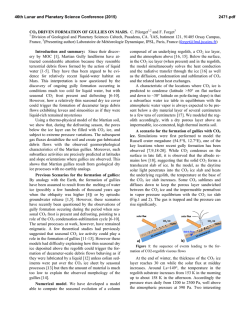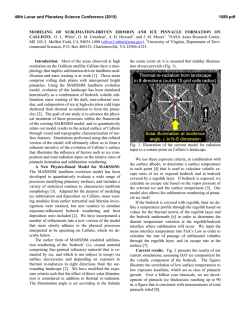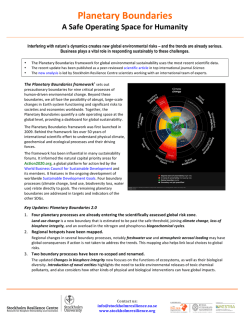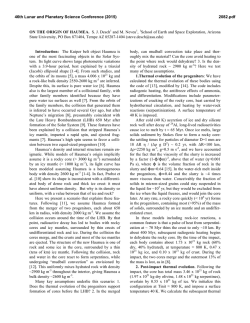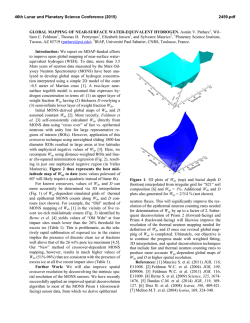
BLACK SHEEP AND WHITE ELEPHANTS: COMPOSITIONS OF
46th Lunar and Planetary Science Conference (2015) 2834.pdf BLACK SHEEP AND WHITE ELEPHANTS: COMPOSITIONS OF SURVIVORS FROM COLLISIONS OF DIFFERENTIATED ICE-ROCK BODIES. G. Sarid1 and S. T. Stewart2, 1University of Central Florida, Florida Space Institute, 12354 Research Parkway, Orlando, FL 32826, U.S.A ([email protected]). 2UC Davis, Earth and Planetary Sciences Department, One Shields Avenue, Davis, CA 95616, U.S.A. Introduction: Minor icy bodies beyond Jupiter’s orbit preserve crucial information about the formation and evolution of the outer planetary disk. Early thermal and collisional processes affected such planetesimals to varying degrees depending on the time scale and dynamics of early planet growth. Recent observations have revealed that many large (>~1000 km in diameter) trans-Neptunian objects (TNOs) exhibit features of crystalline water ice in their surface spectra, as well as spectral features of more volatile ices [1, 2]. There is also increasing evidence now that multiple systems exist among icy body populations and are in complex physical states, which should owe their provenance to large disruptive collisions between at least partially differentiated bodies [3, 4, 5]. The internal differentiation and surface composition of objects in these systems depends not only on their impact history, but also on the thermo-chemical alteration modes. These telltale observations should be accounted for when considering the alteration history and bulk processing of dwarf planets and their icy-rocky progeny. Our approach is aimed at addressing the following issues: (i) What processes led to the observed diversity of dwarf planets?; (ii) How much internal heat is gained and retained through radioactive decay and episodic large collisions?; (iii) What should be the relative abundance of organic molecules and volatile ices (CO, CH4, N2 etc.) that survive during the early violent evolution of the outer planetary disk? Modeling Issues: Our initial model for an the objects in question is that of a porous aggregate of various volatile compounds (as ices or trapped gases) and refractory silicate-metal solid grains, comprising the bulk matrix [6]. Chemical compositions for these objects are taken from existing simulations of chemical and dynamical evolution of disk material [7]. The key volatile species (e.g., H2O, CO, CO2, NH3, CH4) are also the most commonly observed in comets [8], which are remnants of such an early planetesimal population. Thermal and chemical internal evolution is examined self-consistently, as the abundances and locations of all species evolve, and we record mass ratios, temperatures, pressures and porosity variations [6, 9]. The presence of volatile species in the interior can affect the overall heat balance and accompanied phase transitions [9, 10]. Another important factor involving volatiles, mostly water ice, is the effect of shock-induced melting and vaporization on the fragmentation and flow regimes within the body, during massive collision events [11, 12]. To explore the effects of collisions on the internal distributions of volatiles, we conduct 3D numerical simulations of collisions between icy-rocky bodies. We utilize both the CTH shock physics code [13] and a version of the SPH code GADGET2, which was modified to handle tabulated equations of state, and has been used previously in simulating giant planetary impacts [14, 15]. Results: We follow a long-term thermal evolution calculation (~1 Gyr), through the bulk alteration of temperature, porosity and composition for icy dwarf planets (>1000 km in diameter). Some initial configurations result in a complex, differentiated structure. Fig. 1 shows a snapshot of the internal temperature, porosity and composition profile for a 1000 km-radius body, at the end of a long-term calculation. We can see a complex, differentiated structure, where the deep interior holds a few percent of water melt fraction, while there are shallower layers that can retain conditions for volatile ice preservation (CO2 and HCN, for this specific model). There exists a distinct separation between the warmer interior, which is much more compacted and hydrous, and the colder exterior, which is much more porous and stratified. If an evolved object, such as this, is subject to a massive collision, the effects of partial melting and porosity quenching may actually serve to trap more volatile species. This means that the deep interior will not necessarily experience extreme alteration. Such an effect could even be more pronounced for porous or partially-differentiated objects. Fig. 2, top panel, shows a snapshot of an SPH collision simulation of two differentiated ice-rock bodies (colors denote rock, hydrated mineral rock and water ice). The composition is roughly similar (rock/ice mass ratio = 2.5), with the target having D = 1200 km and the impactor's D = 600 km. The collision is oblique (45 deg.) at a v = 1 km/s (quiescent Kuiper belt conditions). We see that through the collision event there are several smaller fragments being ejected that are predominantly icy or rocky. The end distribution of material closer and on the surface is much less homogeneous than the initial composition and includes much larger fractions of rock. The bottom panel of Fig. 2 shows the pressure conditions experienced by the ice component (“crust”) of the target. Pressure regimes for water ice are denoted by colors as pore crush strength (0.1 GPa), incipient water ice melting (1.6 GPa) and 46th Lunar and Planetary Science Conference (2015) complete water ice melting (3.48 Gpa) [12]. We see that the overall melt fraction is small (~ 1%) and most of the work is spent in porosity quenching. This compaction can be effective at increasing thermal conductivity and reducing flow permeability. We focus on understanding the effects of different collision regimes (e.g., merging, disruption, hit-andrun, and graze-and-merge) on early volatile preservation. These regimes include potential family-forming collisions between differentiated bodies [16]. In the future, such results can be used to estimate the cumulative effects of multiple impacts. Acknowledgements: This work was partly supported by NASA OPR grants NNX09AP27G and NNX12AK25G. References: [1] Barkume K. M. et al. (2008) AJ, 135, 55-67. [2] Barucci M. A. et al. (2008) A&A, 479, L13-L16. [3] Brown M. E. et al. (2007) Nature, 446, 294-296. [4] Noll. K. et al .(2008) The Solar System Beyond Neptune, U. Arizona Press, 345-363. [5] Canup, R. (2011) AJ, 141, 35. [6] Sarid G. and Prialnik D. (2009) MAPS, 44, 1905-1916. [7] Bond J. C. et al. (2010) ApJ, 715, 1050-1070. [8] Bockelee-Morvan D. et al. (2004) Comets II, U. Arizona Press, 391-423. [9] Prialnik D. et al. (2008) SSRv, 138, 147-164. [10] Desch S. J. et al. (2009) Icarus, 202, 694-714. [11] Leinhardt, Z. M., et al. (2008) The Solar System Beyond Neptune, U. Arizona Press, 195-211. [12] Kraus R. G., Senft L. E. and Stewart S. T. (2011) Icarus, 214, 724-738. [ 1 3 ] McGlaun, J.M., et al. (1990) Int. J. Impact Eng. 10, 351-360. [14] Marcus, R. A. (2009) AJ, 700, L118-L122. [15] Cuk, M. and Stewart, S. T. (2012) Nature, 338, 1047-1052. [16] Cook, J. C. et al. (2011) 42nd LPSC, LPI #1608, 2503. 2834.pdf Figure 2. Top: Snapshot sequence of a collision between 2 ice-rock differentiated bodies with a mass ratio of 8:1. The colors denote core (rock – red), mantle (hydrated – orange) and crust (ice – white). Bottom: Pressures experienced by the ice component of the target body (by mass fraction), designated by pressures exceeding pore strength (black), incipient (blue) and complete (red) melting. Figure 1. Radial profiles (clock-wise from top left) of temperature, porosity, mass fraction of volatile species trapped as ices (log scale) and melt fraction of water (log scale). For layers shallower than ~ 800 km, the water melt fraction is negligible , while deeper than that there are fraction of 0.1% to 3%. The volatile ices are concentrated in shallower layers, a few km thick.
© Copyright 2026


